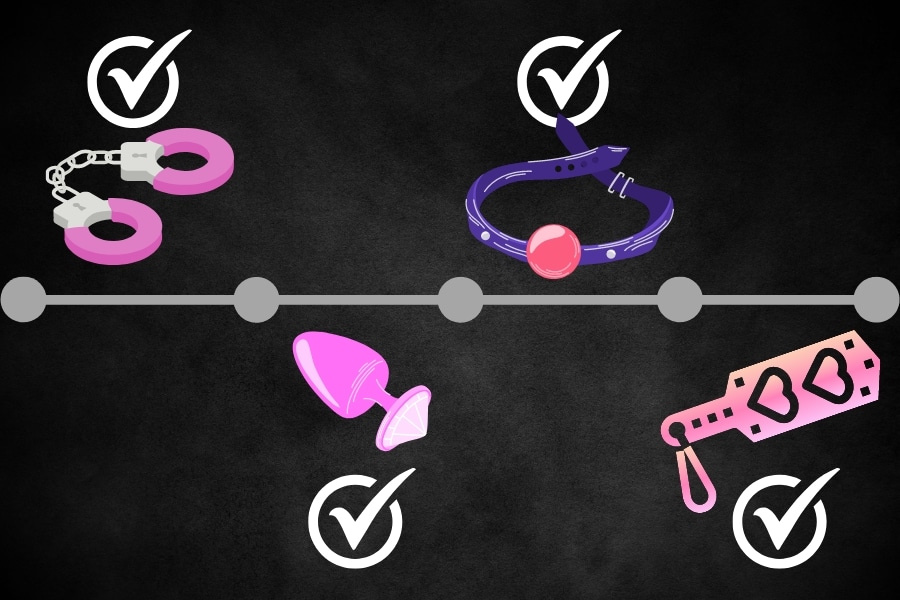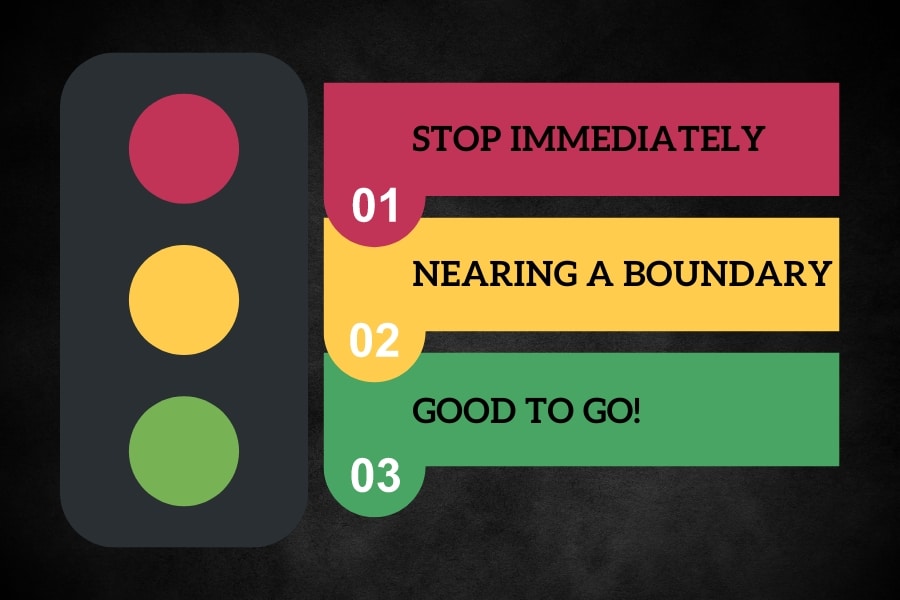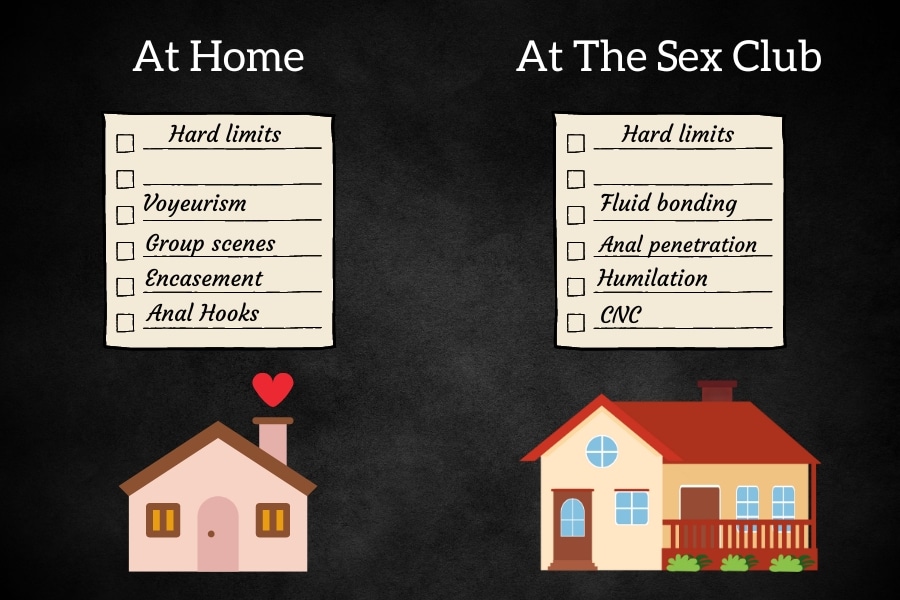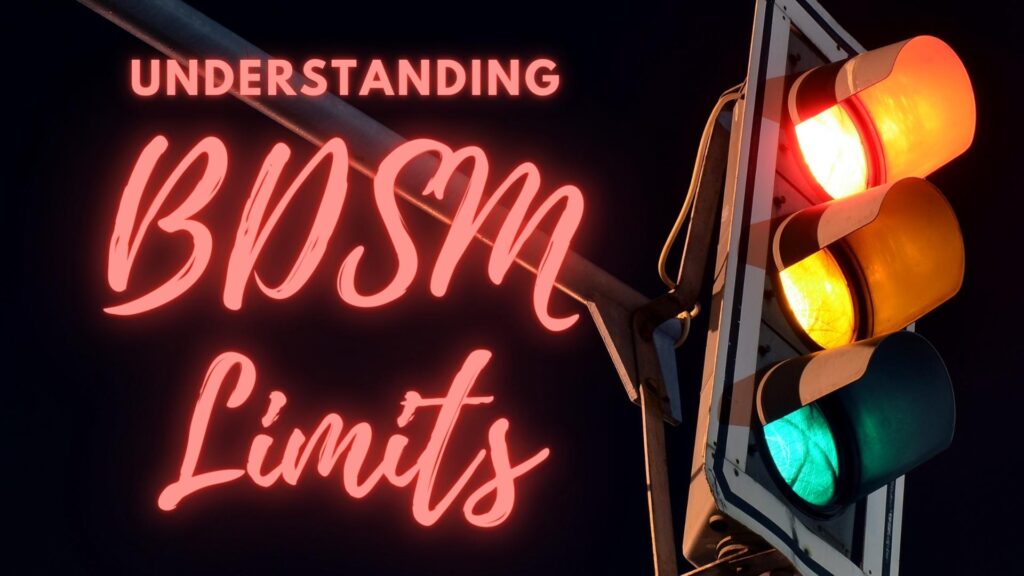Navigating the multifaceted world of BDSM can be both an exhilarating and overwhelming experience. A big part of this kinky exploration is the understanding and establishment of personal ‘limits’. But what exactly are these limits? How do they differ, and why are they so essential for practicing BDSM safely and consensually? This blog post delves deep into the realm of BDSM limits, looking at the difference between ‘hard’ and ‘soft’ limits, and offering insightful examples to guide all kinds of kinksters out there!
Whether you’re seasoned in the BDSM community or taking your first naughty steps, this comprehensive guide will inspire and assist you in crafting your own personal limits, making sure that every kinky experience is safe, consensual, and thrillingly satisfying.
Here’s what we will cover today:
- What Are BDSM Limits?
- Examples of BDSM Limit Lists
- BDSM Limit Checklist: To Inspire Exploration
- Tips For Making Your Own List of BDSM Limits
What Are BDSM Limits?
In the vast and varied world of BDSM, communication is crucial, ensuring that every act is safe, consensual, and fulfilling for all parties involved. This is where BDSM limits come into play. Essentially, these limits are the boundaries set by individuals to clarify what they are and aren’t comfortable with in a BDSM context.
BDSM limits can encompass a wide range of aspects:
- Sexual Acts: Specific acts one might or might not be comfortable with, such as bondage, roleplay, or anal sex.
- Materials: Some might have aversions or allergies to materials like latex, leather, metal, glass, rope, or rubber.
- Tools: From BDSM whips to ropes to handcuffs, not all BDSM toys or tools is for everyone. Some might be off-limits due to personal preferences or past experiences.
- Places: This can refer to locations where BDSM activities may take place, such as public settings, certain rooms, or specific venues.
- Fluids: Some individuals might be averse to certain bodily fluids, either for personal, safety, or health reasons.
- Words: Certain trigger words or phrases that can cause discomfort or distress.
- Body Parts: Some might have specific body parts that are off-limits for touch or impact, perhaps due to personal sensitivities or past traumas.
- Bruising Level: Some people enjoy the aftermath of impact play, such as bruising, while others might want to avoid visible marks or even permanent scars.
- Time Limits: Duration of a particular scene or act might be crucial. Some might only be comfortable with certain activities for a short duration, while others might be open to longer sessions.
Soft BDSM Limits
Soft limits refer to activities that someone is open to yet still hesitant or uncertain about. They might be activities that a person is curious about but needs to approach with caution, or they might be activities that require specific conditions to be met. Soft limits can be negotiable and might change over time based on experiences, trust levels, and evolving preferences. It’s a “maybe” zone that requires open communication between participants and careful experimentation.
Hard BDSM Limits
Hard limits, on the other hand, are non-negotiable boundaries. These represent activities, tools, or scenarios that an individual is unequivocally not willing to engage in or experience. Respecting hard limits is crucial in the BDSM community, as pushing or violating these limits is a breach of trust and can lead to physical or psychological harm. Hard limits are firm “no-go” areas that remain consistent over time. However, any kinkster may find that one of their hard limits becomes more of a soft limit over time, and may be open to careful exploration at some point. Although, this is never anything that is up for negotiation, but rather something that can develop over time.
In both cases, it’s essential for participants to discuss, establish, and respect these limits to maintain trust, safety, and mutual satisfaction in any BDSM interactions.
Examples of BDSM Limit Lists
So, putting your BDSM limits into a list is fairly simple. You can even customize the layout and the medium for your list to however you prefer to have this information available to you or your partner(s).
The format you choose largely depends on your comfort level, convenience, and how you’re planning on communicating with your partner. Here’s a quick rundown of a few different formats to consider:
- Literal Lists on Paper: Old-school and tactile, jotting down limits on paper can be both therapeutic and clear. Plus, having a physical copy can be handy for face-to-face discussions.
- Embedded in Your Sexual Contract: For those who draft BDSM contracts, incorporating your limits within this document ensures they’re central to any agreement. It formalizes your boundaries and emphasizes their importance.
- Shared Document Online: Platforms like Google Docs or Dropbox Paper allow both parties to access, edit, and comment on the list in real-time. This fosters open communication on-the-go and the option for quick dynamic adjustments.
- Notes App: Use your built-in notes apps, making it easy to have your limits accessible anytime, anywhere. Apps often come with sharing options, allowing you to easily communicate your limits with a partner.
- Simply Verbal: Some prefer the intimacy of discussing limits face-to-face without a written list. This method requires trust, good memory, and often, repeated communication to ensure clarity.
No matter the format, the most crucial aspect is clear communication and mutual understanding. Find what works best for you and ensures your BDSM experiences remain safe and consensual.
What a BDSM Limits List Can Look Like
Fancy a peek into another kinkster’s BDSM limit list? I’ve called up some familiar faces in the kinky area and taken a sneak peek in their BDSM limits. Here are some examples of some lists of soft BDSM limits and hard BDSM limits.
| Soft Limits | Hard Limits |
| Choking | Needles |
| Face slapping | Fisting |
| Metal cuffs | Spitting in mouth |
| Anal play | Anal/vaginal speculums |
| Sex in public | Permanent scarring |
| Urine play | Urine in mouth |
| Verbal degradation | Restrained for over 1 hour |
| LGDD Roleplay | Suspension |
| Double penetration | Blood/feces |
And another example…
| Soft Limits | Hard Limits |
| Deepthroating | Watersports |
| Hard spanking (with hands) | Spanking tools (paddle or crop) |
| Butt plugs | Anal sex (PIA) |
| Light bondage | Predicament bondage |
| Nipple clamps | Genital clamps |
BDSM Limit Checklist: To Inspire Exploration
It can be hard to think of your specific BDSM limits just like that. We often like to focus on things we would like for someone to do to us. If we’re not used to incorporating a certain act in the bedroom (or dungeon) it’s not so surprising that it’s difficult to think of on a whim. Sometimes you just need some inspiration. That’s exactly what I have for you here!
I recommend going straight to Edwina’s blog post with our GIGANTIC list of kinks and fetishes for some comprehensive inspiration. Scroll down to the section on kinks and search your soul!
Below I’ve given you a small snippet of some of the items on her list. Just a few of the many many things you could incorporate in your own BDSM limits list.
Of course, you don’t have to confront how you feel about each and every item here. This is just for inspiration. If you see anything that provokes a reaction, you might want to figure out whether it might be something you could be open to experiencing under the right circumstances (soft BDSM limit) or something you wouldn’t ever touch with a ten-foot pole (hard BDSM limit). Enjoy!
Items You Might Find on a BDSM Limits List:
- Anal play (anal fingering, anal toys, small anal toys, anal toys for men, BDSM anal toys, anal sex, analingus, anal gaping etc.)
- Age play
- Blindfolding
- Facial restraints (different types of ball gags like, normal ball gags, an open mouth gag, dildo gag, fleshlight gag, hook gag, etc.)
- Bondage rope
- Suspension
- Handcuffs & ankle cuffs
- Full body restraint systems
- Bondage tape
- Creampies
- Breath play
- Cock and Ball torture
- CNC (consensual non-consent)
- Facials
- Degradation
- Humiliation (private or public)
- Dirty talk
- Discipline & punishment
- Double penetration
- Cock cage
- Labia clamps
- Blood play
- Video recording, audio recording, or photos
- Abrasion
- Forced orgasms
- Roleplaying (abduction, interrogation, rape fantasy, gang bang, initiation rites, medical scenes, prison scenes, school room scenes, religious scenes, LGDD (Little Girl/Daddy Dom), fantasy, strangers, and many many more…)
- Urine play
- Feces (or no poop on purpose, at least…)
- Face sitting
- Figging
- Fisting
- Hair pulling
- Encasement
- Needle or knife play
- Puppy play
- Pony play
- Sex in public
- Public exposure
- Sounding
- Wax play
- Nipple clamps
- Nipple tuggers
- Spit (on genitals, in mouth)
- Electroplay
- Caning
- Whipping
- Exhibitionism
- Voyeurism
- Ruined orgasms
- Tickling
Tips For Making Your Own List of BDSM Limits
Account for the Intensity Levels on the List

The same sexual act may exist on different lists (or on no list at all) depending on the intensity at which it’s performed or practiced. There’s a big difference between light face slapping during choking or hair pulling and very intense slaps to the face from a bigger distance. Clarify the intensity level and setting you’re comfortable with on the list.
Incorporate Check-ins Before or During Your Sessions

Just because someone has made an extensive BDSM limits list, it does not mean that they’re always willing to perform every act on those soft limit lists. Like with any other sexual activity, you might just not be in the mood for a certain act at a certain time. It’s everyone’s responsibility to regularly check in with their partner(s) before or during your session to ensure enthusiastic consent for any specific acts you’re about to embark on.
Use a Gradual Safeword System

This is a great way to work with soft and hard BDS limits. Use a few predetermined safewords that indicate different gradual levels of comfort.
My favorite is the traffic light system. It’s so beautifully simple!
- Green means: “Go ahead, continue with whatever you’re doing”.
- Yellow means: “Be cautious with what you’re doing now, I may be close to reaching my limit.” Here, it’s a good idea to decrease the intensity, speed, depth of penetration of whatever you’re doing. Be aware of your partner’s cues and listen to how they respond to any kind of stimulation.
- Red, of course, means: “Stop what you’re doing immediately”. After you’ve stopped and removed all your equipment, sex toys, restraints etc., you can talk about what it is that made either one of you get to that limit. Talk about how your list of soft and hard BDSM limits have changed now.
Using this gradual system is also a great way to discover new limits (and new pleasures) when used patiently. While you should always talk openly about the things that are going to take place in your session, this system allows you to experiment with different levels of intensity and perhaps even different kinds of equipment.
Different Lists for Different Settings

Do you know the feeling of only wanting to do certain sexual acts with certain people that you fully trust and being less open to experimenting with newer partners? If you have multiple partners or frequently attend sex parties, or are a member of a sex club, your hard and soft BDSM limits may very well vary from person to person, as well as from setting to setting. I recommend making separate lists for separate scenarios. One list for the sex club, one list for this sexual partner, and another for a different partner.
Conclusion: It’s Always Good to Know Your Own Limits
Sometimes a BDSM limits list will be an indication that you and your partner are sexually incompatible. If someone’s favorite part of kinky sex is one of your hard BDSM limits, your sexual relation will have some shortcomings. Therefore, it’s a good idea to be open about these limits and potential for sexual compatibility from the get-go. However, smaller instances of sexual incompatibility might also just be a catalyst to looking into having an open relationship. Ideally, both you and your partner should be able to consensually fulfill your needs in a way that respects everyone involved.
That is truly the key to anything relating to any kind of BDSM limit. Be respectful of people’s ever-changing boundaries, comfort levels, and consent. Making and sharing BDSM limit lists will help you maintain a happy and healthy kinky lifestyle!












